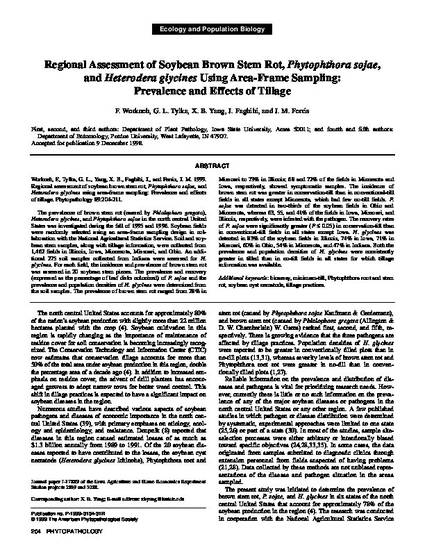
The prevalence of brown stem rot (caused by Phialophora gregata), Heterodera glycines, and Phytophthora sojae in the north central United States was investigated during the fall of 1995 and 1996. Soybean fields were randomly selected using an area-frame sampling design in collaboration with the National Agricultural Statistics Service. Soil and soybean stem samples, along with tillage information, were collected from 1,462 fields in Illinois, Iowa, Minnesota, Missouri, and Ohio. An additional 275 soil samples collected from Indiana were assessed for H. glycines. For each field, the incidence and prevalence of brown stem rot was assessed in 20 soybean stem pieces. The prevalence and recovery (expressed as the percentage of leaf disks colonized) of P. sojae and the prevalence and population densities of H. glycines were determined from the soil samples. The prevalence of brown stem rot ranged from 28% in Missouri to 73% in Illinois; 68 and 72% of the fields in Minnesota and Iowa, respectively, showed symptomatic samples. The incidence of brown stem rot was greater in conservation-till than in conventional-till fields in all states except Minnesota, which had few no-till fields. P. sojae was detected in two-thirds of the soybean fields in Ohio and Minnesota, whereas 63, 55, and 41% of the fields in Iowa, Missouri, and Illinois, respectively, were infested with the pathogen. The recovery rates of P. sojae were significantly greater (P ≤ 0.05) in conservation-till than in conventional-till fields in all states except Iowa. H. glycines was detected in 83% of the soybean fields in Illinois, 74% in Iowa, 71% in Missouri, 60% in Ohio, 54% in Minnesota, and 47% in Indiana. Both the prevalence and population densities of H. glycines were consistently greater in tilled than in no-till fields in all states for which tillage information was available.
Available at: http://works.bepress.com/gregory-tylka/185/

This article is published as Workneh, F., Tylka, G. L., Yang, X. B., Faghihi, J., and Ferris, J. M. 1999. Regional assessment of soybean brown stem rot, Phytophthora sojae, and Heterodera glycines using area-frame sampling: Prevalence and effects of tillage. Phytopathology 89:204-211, doi: 10.1094/PHYTO.1999.89.3.204. Posted with permission.